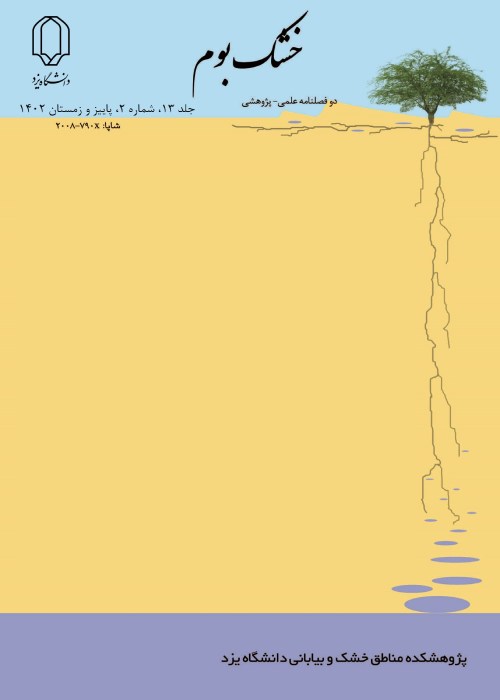Application of Rainfall Time Series and Climatic Indices for Drought Prediction using Co-Active Neurofuzzy Inference System (Case Study: Birjand, Southern Khorasan)
Author(s):
Abstract:
Drought forecasting is an important tool for managers for exploitation of the limited resources of soil and water. Recently, Southern Khorasan has become one of the main centers in the country which suffers from severe drought. This study was aimed to assess the capability of CANFIS for drought forecasting of Birjand area through the combination of global climatic signals with rainfall and previous values of Standardized Precipitation Index (SPI). SPI was used to define and monitor the drought event in monthly time scale. In this study, nine global climatic indices were selected for drought simulation. Using stepwise regression and correlation analyses, the signals NINO 1, NINO 3, MEI, TSA, AMO and NINO 3.4 were recognized as the effective signals on the drought event in Birjand. In this work, for modeling, 41 years of climatic data records (1970-2010) were collected in which 60%, 15%, and 25% of them were extracted to be used in training, cross validation and testing processes, respectively. The momentum algorithm with Gaussian fuzzy membership function was utilized in network training process. Based on the results from stepwise regression analysis, 12 models were extracted for further processing by CANFIS. However, due to the limitation of CANFIS in the execution of training process with the inputs higher than 5, only 8 models were analyzed using CANFIS. Sensitivity analysis showed that for all models, NINO indices and rainfall variable had the largest impact on network performance. In model No. 4, as the model with the lowest error during training and testing processes, NINO 1(t-5) with an average sensitivity of 0.7 showed the highest impact on network performance. After that, the variables rainfall, NINO 1(t) and NINO 3(t-6) with the average sensitivity of 0.59, 0.28 and 0.28, respectively could have the highest effect on network performance. According to network performance metrics, it was established that the global indices with a time lag represented a better correlation with ENSO. Finally, the fourth model with a combination of the input variables NINO 1 (with 5 months of lag and without any lag), monthly rainfall and NINO 3 (with 6 months of lag) showed a correlation coefficient of 0.903 (between observed and simulated SPI) and was selected as the most accurate model for drought forecasting using CANFIS in the climatic region of Birjand.
Keywords:
Drought forecasting , Climatic signals , SPI , CANFIS , ENSO
Language:
Persian
Published:
Journal of Arid Biome, Volume:5 Issue: 2, 2016
Pages:
51 to 67
magiran.com/p1542923
دانلود و مطالعه متن این مقاله با یکی از روشهای زیر امکان پذیر است:
اشتراک شخصی
با عضویت و پرداخت آنلاین حق اشتراک یکساله به مبلغ 1,390,000ريال میتوانید 70 عنوان مطلب دانلود کنید!
اشتراک سازمانی
به کتابخانه دانشگاه یا محل کار خود پیشنهاد کنید تا اشتراک سازمانی این پایگاه را برای دسترسی نامحدود همه کاربران به متن مطالب تهیه نمایند!
توجه!
- حق عضویت دریافتی صرف حمایت از نشریات عضو و نگهداری، تکمیل و توسعه مگیران میشود.
- پرداخت حق اشتراک و دانلود مقالات اجازه بازنشر آن در سایر رسانههای چاپی و دیجیتال را به کاربر نمیدهد.
In order to view content subscription is required
Personal subscription
Subscribe magiran.com for 70 € euros via PayPal and download 70 articles during a year.
Organization subscription
Please contact us to subscribe your university or library for unlimited access!


